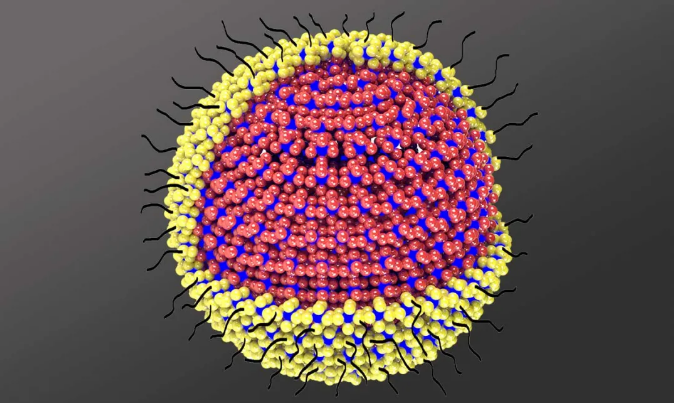Quantum dot coatings can make aircraft inspection quick and easy
QQ Academic Group: 1092348845
Detailed

Image: Air Force Institute of Technology/American Chemical SocietyGraphic of a colloidal quantum dot where the inner core (pink), outer shell (yellow), and polymer ligands (black lines) can be seen.
not
The technicians here can test the airworthiness of the aircraft fuselage, check the structural integrity of the bridge or check the complex 3D printed parts for defects only by quickly scanning the camera. Researchers at the US Air Force Institute of Technology and Los Alamos National Laboratory are developing a coating containing quantum dots that can achieve this. The researchers said that manufacturers can apply this kind of paint to surfaces including vehicles, infrastructure and parts. Inspectors or quality assurance experts can quickly measure the strain (deformation) on these surfaces by analyzing the emitted light.
In order not to damage the surface during todays testing, the technician may generate a magnetic field, but this usually requires bulky equipment and provides results that are difficult to read. They may also use X-rays, which can cause radiation safety issues. Other scanning methods, such as ultrasound or microwave, are limited in the materials they can measure.
"Imagine holding a camera and seeing a two-dimensional strain surface map on the screen," said Michael Sherburne of the Air Force Institute of Technology, one of the researchers who developed the infused quantum dot coating.
Quantum dots are semiconductor particles several nanometers wide. Their small size brings some unique quantum effects, as if each quantum dot is an artificial atom. For example, quantum dots emit light when excited by electromagnetic radiation. The wavelength of the emitted light varies according to the size of the dots, and the smaller dots emit blue light.
The "paint" consists of quantum dots suspended in a transparent polymer. These dots emit green light under ultraviolet light. Other quantum dot coatings do exist, but they are mainly used for aesthetics, such as giving light to objects in the dark.
The quantum dots of this coating have an additional characteristic: when they are stretched or squeezed, the wavelength of the light they emit will change, becoming shorter (bluer) or longer (redder), which It depends on whether they are stretched or squeezed. The researchers envisioned a camera that uses a laser to irradiate ultraviolet light on a painted surface, then captures the resulting radiation and draws a surface strain map.
Kirk Schanze, a professor of chemistry at the University of Florida, said the idea of using light to measure strain has existed for decades, but using quantum dots to achieve this goal is still a new idea.
However, this coating does have its limitations. First, very high temperatures will melt the polymer. Of course, quantum dot coatings can only measure the strain that occurs after the coating is applied; for example, if a technician applies it on an old airplane, the coating will not show any deformation that occurred before.
But Sherburne wanted to solve the latter problem. "This must be a future job," he said.
In addition to making the inspection process faster and easier, this coating may be more versatile than todays strain-sensing instruments. Manufacturers can apply it to 3D printed parts with complex shapes, which are not suitable for todays strain measurement technology. In addition, a device can transmit ultraviolet light through fiber optic cables, which can scan surfaces that are difficult to reach elsewhere.
Schanze called the researchers work "an interesting proof of concept," but he said the way to use this pigment for full-scale measurements is unclear.
Sherburne also believes that any practical application still has a long way to go. The next step is to build a camera system that scans under ultraviolet light and measures the returned color. Although this technology already exists, researchers have not yet developed it beyond a concept. Therefore, it may take more than ten years for maintenance personnel to start applying strain-sensitive paint on the bridge and scanning with ultraviolet light.
- Previous: What are the important
- Next: A Rising 2D Star: Nove


 Academic Frontier
Academic Frontier
